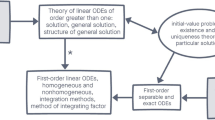Abstract
This article explores the types of interactions that take place within “Interactive Groups” when individuals come to a meaningful understanding of mathematics. We discuss the possibility for dialogic talk to unveil the process of learning, and we explore the role that tutors may play in making this process happen. We postulate that learning-with-understanding may occur more likely in dialogic spaces where individuals use dialogic talk. We use a methodological tool to analyse interaction, drawing on video-recorded data. We conclude that dialogic talk may generate meaningful learning situations that may improve children’s mathematics learning. However, dialogic interaction may also prompt students to use claims that are not mathematically valid. The role of the adult to guide interaction within such situations needs to be further explored.






Similar content being viewed by others
Notes
Wood et al. (1986) distinguish between recruitment, reduction in degrees of freedom, direction maintenance, marking critical features, frustration control and demonstration, as steps of the scaffolding process.
References
Behr, M. J., Harel, G., Post, T., & Lesh, R. (1992). Rational number, ratio, and proportion. In D. Grouws (Ed.), Handbook of research on mathematics teaching and learning (pp. 296–333). New York: Macmillan Publishing.
Bruner, J. S. (1961). The act of discovery. Harvard Educational Review, 31, 21–32.
Bruner, J. (2012). What psychology should study. International Journal of Educational Psychology, 1(1), 5–13.
Denzin, N. K. (1970). The research act: A theoretical introduction to sociological methods. Chicago: Aldine.
Edwards, D. (1993). But what do children really think? Discourse analysis and conceptual content in children’s talk. Cognition and Instruction, 11(3–4), 207–225.
Elbers, E., & Streefland, L. (2000). Collaborative learning and the construction of common knowledge. European Journal of Psychology of Education, 15(4), 479–490.
Elboj, C., & Niemelä, R. (2010). Sub-communities of mutual learners in the classroom: The case of interactive groups. Revista de Psicodidáctica, 15(2), 177–189.
Flecha, R. (2000). Sharing words: Theory and practice of dialogic learning. Lanham, MD: Rowman & Littlefield.
Forman, E., & Larreamendy-Joerns, J. (1998). Making the implicit explicit: Classroom explanations and conversational implicatures. Mind, Culture, and Activity, 5(2), 105–113.
Garcia Carrión, R., & Díez-Palomar, J. (2015). Learning communities: Pathways for educational success and social transformation through Interactive Groups in Mathematics. European Educational Research Journal, 14(2), 151–166.
Gómez, A., Elboj, C., & Capllonch, M. (2013). Beyond action research. The communicative methodology of research. International Review of Qualitative Research, 6(2), 183–197.
Greeno, J. G. (1997). On claims that answer the wrong questions. Educational Researcher, 26(1), 5–17.
Habermas, J. (1984). The theory of communicative action: Vol. 1. Reason and the rationalization of society. Boston: Beacon.
INCLUD-ED Consortium. (2009). Actions for success in schools in Europe. Brussels: European Commission.
Kieran, C. (2002). The mathematical discourse of 13-year-old partnered problem solving and its relation to the mathematics that emerges. In C. Kieran, E. Forman, & A. Sfard (Eds.), Learning discourse (pp. 187–228). Dordrecht: Kluwer.
Kieran, C., & Dreyfus, T. (1998). Collaborative versus individual problem solving: Entering another’s universe of thought. In A. Olivier & K. Newstead (Eds.), Proceedings of the 22nd PME (Vol. 3, pp. 112–119). Stellenbosch, South Africa.
Kieren, T. E. (1976). On the Mathematical, cognitive and instructional foundations of rational numbers. In R. A. Lesh & D. A. Bradbard (Eds.), Number and measurement. Papers from a research workshop (pp. 101–144). ERIC (ED 120 027).
Larson-Novillis, C. (1979). Locating proper fractions on number lines: Effects of length and equivalence. School Science and Mathematics, 53, 423–428.
Lobato, J., Clarke, D., & Ellis, A. B. (2005). Initiating and eliciting in teaching: A reformulation of telling. Journal for Research in Mathematics Education, 36(2), 101–136.
Mercer, N., & Howe, C. (2012). Explaining the dialogic processes of teaching and learning: The value and potential of sociocultural theory. Learning, Culture and Social Interaction, 1(1), 12–21.
Mercer, N., & Sams, C. (2006). Teaching children how to use language to solve maths problems. Language and Education, 20(6), 507–528.
Mertens, D., & Sordé, T. (2014). Mixed methods research with groups at risk: New developments and key debates. Journal of Mixed Methods Research, 8(3), 207–211.
Rogoff, B., Turkanis, C. G., & Bartlett, L. (2001). Learning together: Children and adults in a school community. New York: Oxford University Press.
Sfard, A. (2002). There is more to discourse than meets the ears: Looking at thinking as communicating to learn more about mathematical learning. In C. Kieran, E. Forman, & A. Sfard (Eds.), Learning discourse (pp. 13–57). Dordrecht: Kluwer.
Soler, M., & Flecha, R. (2010). Desde los actos de habla de Austin a los actos comunicativos. Perspectivas desde Searle, Habermas y CREA. Signos, 43(2), 363–375.
Valls, R., & Kyriakides, L. (2013). The power of Interactive Groups: How diversity of adults volunteering in classroom groups can promote inclusion and success for children of vulnerable minority ethnic populations. Cambridge Journal of Education, 43(1), 17–33.
Vygotsky, L. S. (1978). Mind and society: The development of higher mental processes. Cambridge, MA: Cambridge University Press.
Wertsch, J. V. (1998). Mind as action. New York: Oxford University Press.
Wood, D., Bruner, J. S., & Ross, G. (1986). The role of tutoring in problem solving. Journal of Child Psychology and Psychiatry, 17(2), 89–100.
Zack, V., & Graves, B. (2001). Making mathematical meaning through dialogue: “Once you think of it, the Z minus three seems pretty weird”. Educational Studies in Mathematics, 46(1–3), 229–271.
Author information
Authors and Affiliations
Corresponding author
Rights and permissions
About this article
Cite this article
Díez-Palomar, J., Olivé, J.C. Using dialogic talk to teach mathematics: the case of interactive groups. ZDM Mathematics Education 47, 1299–1312 (2015). https://doi.org/10.1007/s11858-015-0728-x
Accepted:
Published:
Issue Date:
DOI: https://doi.org/10.1007/s11858-015-0728-x




